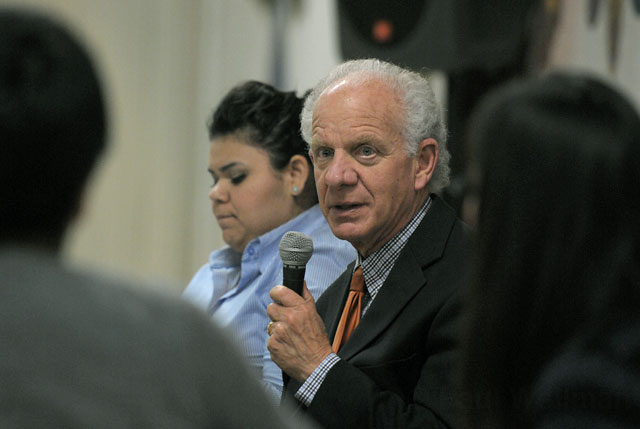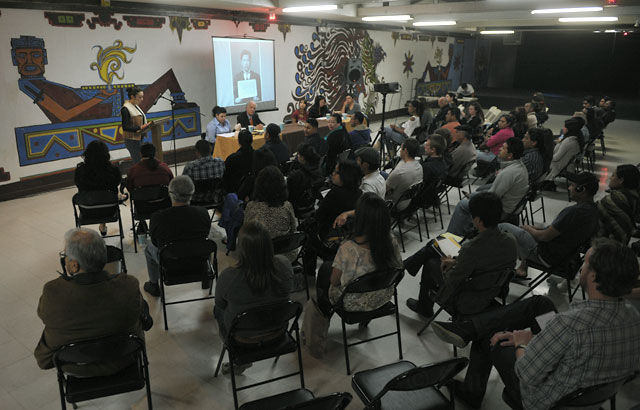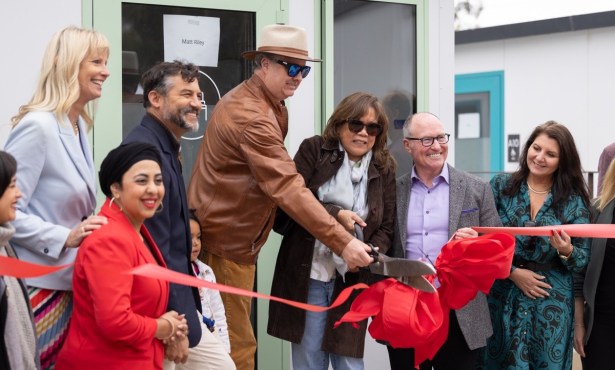The Daunting Rigmarole of Removal
Casa de la Raza and KCSB Host Neighborhood Meeting on Deportation

The federal laws that dictate the deportation of undocumented immigrants are complicated and ever-changing. Authorities have even started to favor the Orwellian term “removal” when describing the judicial gauntlet illegal aliens pass through as they’re sent back to their native countries.
At a neighborhood meeting held Thursday night in Casa de la Raza, Arnold Jaffe, a prominent area lawyer who specializes in immigration law, walked listeners through the legal options available to undocumented migrants who find themselves in federal custody, and the paths they are likely to follow through the American justice system. The U.S. removes around 400,000 aliens a year.
The event was hosted by KCSB, which provided real-time Spanish translation services via transmitters and headphones to some of the 60 or so people in attendance. At the end of it, Cindy Reyna — an undocumented UCSB student who grabbed the attention of news readers and politicians when she was convicted of DUI and forced into deportation proceedings last month — addressed the crowd about her time in custody and where her case stands.
But before Jaffe and Reyna spoke, a video testimonial was played of an undocumented SBCC student who emigrated from Guatemala seven years ago. With his face blurred and his voice distorted, “Tomás” described his journey north, remembering how he saved a woman from drowning in the quick currents of the Rio Grande. He traveled without his family; his pregnant wife and young son remained in Guatemala.
Tomás said he washed dishes and worked a number of jobs to survive in the U.S. — “I started with nothing,” he said — and after three years sent for his wife, and later his children. During their trek north, however, the kids became separated, ushered along by different migrant smugglers called “coyotes.” While Tomás was reunited with his son within a week of the 10-year-old entering the U.S., his daughter proved much harder to track down. Tomás sought the help of Casa de la Raza, whose staff introduced him to Jaffe. After two months, Tomás’s 6-year-old daughter was back with her family.

“No one knows what it’s like to live as an undocumented alien unless you are one,” said Jaffe after the video. “Most people don’t have a clue what it’s like to live in 24-hour jeopardy, knowing you could be pulled over for a minor traffic incident and be sent back. The people braying about illegal immigration — they have no concept.”
If an undocumented immigrant is arrested by local law enforcement — for a minor infraction or serious crime — his or her identity is passed to Immigration and Customs Enforcement (ICE) after they’re booked in County Jail. (All inmates’ fingerprints are sent to ICE once they enter the facility.) If ICE officials think the arrestee is an illegal alien, explained Jaffe, they can place a no-bail immigration hold on them while the matter is investigated.
Once the Santa Barbara detainee has dealt with their county court case — often with the help of a public defender familiar with immigration laws — they are transferred to ICE’s Camarillo detention center for an interview. “While there, give them as much positive information as you can,” advised Jaffe, offering strategies that might save an illegal migrant from removal. “Talk about what you have done to better yourself — school, church, work in the community.” He also said it’s important to disclose if you have a legal and permanent family member living in the U.S.
At that point, ICE has the authority to release the undocumented person without bond, keep them in custody but offer an immigration bond, or hold them without a release option. “If ICE has you, they get to make the decision,” said Jaffe, a Santa Barbara resident since 1977. “But you present your positives. And when you’re done, you beg.”
If arrestees are not granted bond, they have a couple of options. They can opt for voluntary departure — returning to their native country without a punitive deportation order against them — or ask to see a federal judge. If they choose the latter, migrants are sent to another detention facility in Lancaster where a magistrate will hear their case within 30 days.
At this point undocumented inmates can again ask for bond as they fight to stay in the country. That process is a lengthy one, oftentimes taking two to four years. If immigrants are released on bond for the proceedings, they can apply for a work permit, said Jaffe. While there are a few different paths toward potential citizenship, he explained, some are harder to navigate than others.
If aliens can prove they have been in the country for 10 years, don’t have a criminal record, but do have a family member who’s a legal, full-time U.S. resident, they may be granted permanent residency. Establishing that their removal would mean significant hardship for their U.S. family member(s) is a key argument, said Jaffe. Lobbying for political asylum is another option, the lawyer explained, or invoking medical problems that may be exacerbated by deportation.
Jaffe noted that in the last few months, federal authorities have started to use more “prosecutorial discretion” to determine who is placed in removal proceedings. Pilot programs exist in Baltimore and Denver that devote more time and resources to specific cases involving serious criminals, and data from those programs will help inform other jurisdictions how to better prioritize their caseloads, he said. But while the days of random arrests and deportations are over, Jeffe went on, the controversial Secure Communities program still oftentimes casts too wide a net that snags minor offenders or noncriminals, clogging an already overtaxed judicial mechanism.
Once Jaffe wrapped up, an undocumented UCSB student named Neyra Pacheco addressed the crowd. The San Marcos High School graduate, who moved from Oaxaca, Mexico, when she was 5 years old, said the university doesn’t quite know how to deal with undocumented students. It’s a confusing gray area for administrators, she said, and the enrolled are often left feeling befuddled and stressed themselves. Every year, around 25,000 undocumented high school students graduate in California, Pacheco said.
Certain undocumented California college students are now able to apply for in-state tuition — thanks to AB540, upheld in the Supreme Court last year — and the recently enacted state DREAM Act will allow some undocumented students to access financial aid beginning in 2013. The federal version of the DREAM (Development, Relief, and Education for Alien Minors) Act, which offers qualifying young migrants a path to citizenship, was rejected by the Senate last year and likely won’t be revisited until after the November presidential election, Pacheco said.
Pacheco then introduced her peer and friend, Cindy Reyna. Recently released from the aforementioned Camarillo detention center, Reyna is weaving through the legal system to remain in the United States. The part-time model and UCSB senior majoring in communications and linguistics said that when she was handed to ICE officials, she thought she’d never see her family. “I’m really happy I’m out,” she said. “Everybody makes mistakes in life, but the people who know me know I’m a dedicated student.”
Reyna, who wants to work eventually work as a newscaster, continued, “The detention center is not pretty. There, you’re not treated with respect.” Vowing to fight her possible deportation and continue her life in the U.S. on the straight and narrow, Reyna summed up, “This is my home now.”


